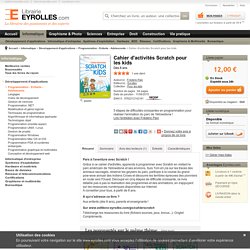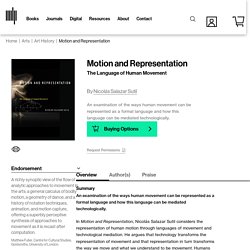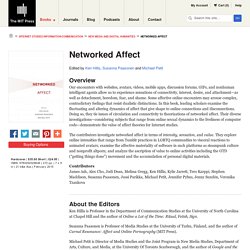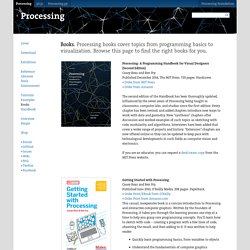

Amazon. Hindawi Publishing Corporation. Cahier d'activités Scratch pour les kids. Pars à l'aventure avec Scratch !

Grâce à ce cahier d'activités, apprends à programmer avec Scratch en visitant le parc américain de Yellowstone et ses environs. Suis Tom et Lila sur les traces des animaux sauvages, observe les geysers du parc, participe à la course du grand pow-wow annuel des Indiens Crows et découvre les terribles épreuves des pionniers en route vers l'Ouest. Découpé en cinq étapes de difficulté croissante, ce livre détaille pas à pas la réalisation des programmes et des animations, en s'appuyant sur les ressources numériques disponibles sur Internet.
À conseiller pour tous, à partir de 8 ans. À qui s'adresse ce livre ? Aux enfants (dès 8 ans), parents et enseignants ! Sur www.editions-eyrolles.com/go/cahierscratch Télécharge les ressources du livre (fichiers sources, jeux, bonus...)- Onglet Compléments. » Note moyenne : 4 / 5 » Donnez votre avis à propos de ce livre » Liste de tous les avis (1 avis) Scratch pour les kids - The LEAD Project. La programmation expliquée aux enfants L'apprentissage de la programmation ouvre aux enfants un monde de créativité et, à terme, d'emplois dans notre société toujours plus numérique.

C'est dans cette optique qu'a été conçu Scratch, un logiciel libre et gratuit qui initie les 8-12 ans à l'informatique en les invitant à créer leurs propres jeux et animations. D'approche très visuelle, fonctionnant par assemblage de briques de couleur, cet outil éducatif a déjà séduit des millions de débutants en programmation dans le monde. Motion and Representation. A richly synoptic view of the flow of analytic approaches to movement in the arts: a general calculus of bodily motion, a geometry of dance, and a history of notation techniques, animation, and motion capture, offering a superbly perceptive synthesis of approaches to movement as it is recast after computation.Matthew FullerCentre for Cultural Studies, Goldsmiths, University of London In this wonderfully wide-ranging book, Nicolás Salazar Sutil provides a powerful and original interpretation of the importance of kinetopoiesis—the movement languages that emerge at the intersection of mathematics, kinematics, and dance.

The Experience Machine. Home. Short Circuits. Soft Circuits. Connected Code. Textures of the Anthropocene. We have entered the Anthropocene era—a geological age of our own making, in which what we have understood to be nature is made by man.

We need a new way to understand the dynamics of a new epoch. These volumes offer writings that approach the Anthropocene through the perspectives of grain, vapor, and ray—the particulate, the volatile, and the radiant. The first three volumes—each devoted to one of the three textures—offer a series of paired texts, with contemporary writers responding to historic writings. A fourth volume offers a guide to the project as a whole. Grain: Granular materials add up to concrete forms; insignificant specks accumulate into complex entities.
Vapor: The vaporous represents matter’s transformations. Ray: A ray is an act of propagation and diffusion, encompassing a chain of interdependencies between energy and matter. These volumes constitute a unique experiment in design and composition as well as content. Networked Affect. Our encounters with websites, avatars, videos, mobile apps, discussion forums, GIFs, and nonhuman intelligent agents allow us to experience sensations of connectivity, interest, desire, and attachment—as well as detachment, boredom, fear, and shame.

Some affective online encounters may arouse complex, contradictory feelings that resist dualistic distinctions. In this book, leading scholars examine the fluctuating and altering dynamics of affect that give shape to online connections and disconnections. Doing so, they tie issues of circulation and connectivity to theorizations of networked affect. Their diverse investigations—considering subjects that range from online sexual dynamics to the liveliness of computer code—demonstrate the value of affect theories for Internet studies. Amazon.fr - Interactive Contemporary Art: Participation in Practice - Kathryn Brown - Livres.
Amazon.fr - Uncertain Images: Museums and the Work of Photographs - Elizabeth Edwards, Sigrid Lien - Livres. ArteXetrA = Art + Etcetera. Re-collection: Art, New Media, and Social Memory. New Media and Digital Humanities. Books \ Processing.org. Processing is also discussed through examples and projects in the following books: By Nick Montfort, Patsy Baudoin, John Bell, Ian Bogost, Jeremy Douglass, Mark C.

Marino, Michael Mateas, Casey Reas, Mark Sample, Noah Vawter. Examples use Processing to explore a modern interpretation of a 1982 Commodore 64 program. Getting Started with ArduinoBy Massimo Banzi. Examples use Processing to communicate with an Arduino board. Building Wireless Sensor Networks: with ZigBee, XBee, Arduino, and ProcessingBy Robert Faludi.
Physical Computing: Sensing and Controlling the Physical World with Computers By Dan O'Sullivan and Tom Igoe. Aesthetic Computing. Hacking Roomba: ExtremeTechBy Tod E. Analog In, Digital OutBy Brendan Dawes. Making Things See: 3D vision with Kinect, Processing, Arduino, and MakerBot (Make: Books): Greg Borenstein: 9781449307073: Amazon.com: Books.